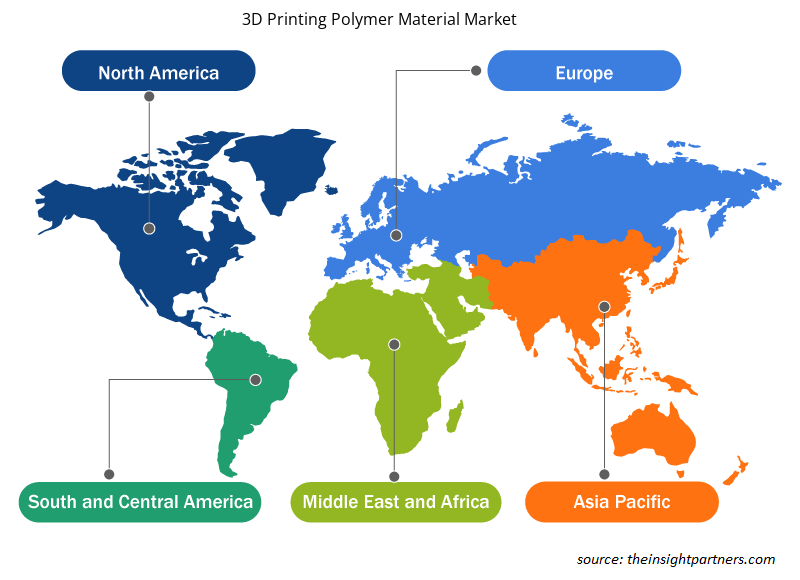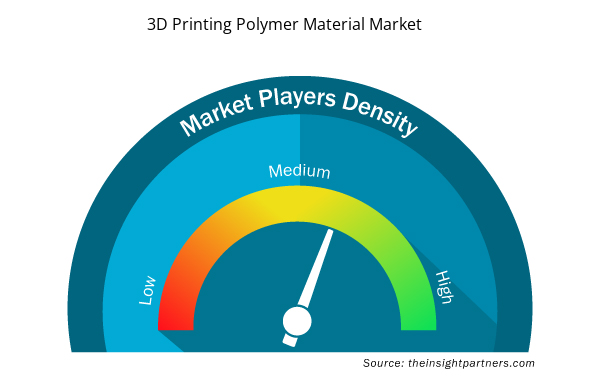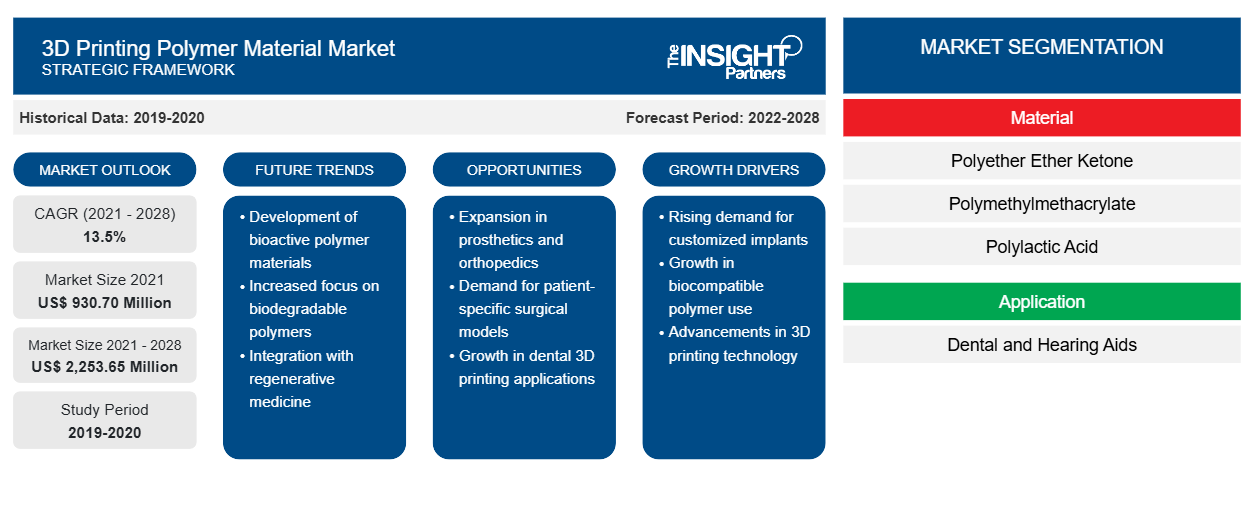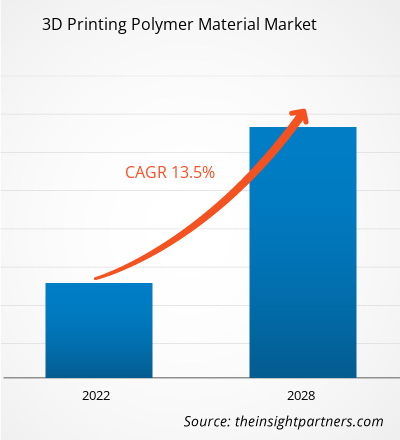El mercado de materiales poliméricos para impresión 3D para aplicaciones médicas se valoró en 930,70 millones de dólares estadounidenses en 2021 y se proyecta que alcance los 2.253,65 millones de dólares estadounidenses en 2028; se espera que crezca a una CAGR del 13,5% entre 2021 y 2028.
Los polímeros son uno de los principales materiales de impresión 3D. La impresión 3D de polímeros es una tecnología emergente que tiene mayores aplicaciones en las industrias, particularmente en el campo médico. El material polimérico de impresión 3D consta de poliéter éter cetona, polimetilmetacrilato y ácido poliláctico. Uno de los principales impulsores del crecimiento del mercado de materiales poliméricos de impresión 3D es el uso cada vez mayor de la impresión 3D en odontología para diversas aplicaciones. En odontología, el uso de la impresión 3D ha experimentado un rápido aumento. Los dentistas utilizan mucho la tecnología de impresión 3D para reemplazar o reparar un diente dañado, crear un modelo de ortodoncia y producir coronas, tapas y dentaduras postizas.
En 2020, América del Norte tuvo la mayor participación en los ingresos del mercado mundial de materiales poliméricos de impresión 3D para aplicaciones médicas . El aumento de la población que envejece y la mayor exposición a ruidos fuertes debido a la rápida urbanización e industrialización en América del Norte están provocando un aumento de la población sorda. Esto está fomentando la demanda de dispositivos para audífonos y, posteriormente, favoreciendo el crecimiento del mercado de materiales poliméricos para impresión 3D en América del Norte para aplicaciones médicas. Según la Encuesta sobre ingresos y participación en programas (SIPP), más de 600.000 personas en los EE. UU. son sordas y aproximadamente 28 millones de la población del país sufre sordera parcial. Por lo tanto, la región está siendo testigo de una demanda de dispositivos para audífonos y brindando oportunidades lucrativas para que los fabricantes de materiales poliméricos 3D amplíen su participación de mercado en América del Norte.
Personalice este informe según sus necesidades
Obtendrá personalización en cualquier informe, sin cargo, incluidas partes de este informe o análisis a nivel de país, paquete de datos de Excel, así como también grandes ofertas y descuentos para empresas emergentes y universidades.
- Obtenga las principales tendencias clave del mercado de este informe.Esta muestra GRATUITA incluirá análisis de datos, desde tendencias del mercado hasta estimaciones y pronósticos.
Impacto de la pandemia de COVID-19 en el mercado de materiales poliméricos para impresión 3D para aplicaciones médicas
Antes de la pandemia de COVID-19, el mercado de materiales poliméricos de impresión 3D para aplicaciones médicas estaba creciendo debido a la alta demanda de polímeros en la impresión 3D para fabricar diferentes dispositivos médicos, instrumentos, implantes personalizados y modelos médicos. Sin embargo, en 2020, varias industrias tuvieron que ralentizar sus operaciones debido a las interrupciones en las cadenas de valor causadas por el cierre de las fronteras nacionales e internacionales. La pandemia de COVID-19 ha afectado negativamente a las economías e industrias de varios países debido a los cierres, las prohibiciones de viaje y los cierres comerciales. La demanda de materiales poliméricos de impresión 3D en aplicaciones como implantes dentales, prótesis dentales, accesorios de implantes y audífonos se ha reducido debido a la baja demanda de estos productos. Sin embargo, la demanda de polímeros de impresión 3D ha aumentado durante la pandemia de COVID-19 para la producción de diferentes equipos de protección personal y dispositivos médicos. La impresión 3D de polímeros se ha establecido como una tecnología viable para producir válvulas de ventilación, gafas de seguridad, protectores faciales e hisopos de prueba durante la pandemia.lockdowns, travel bans, and business shutdowns. The demand for 3D printing polymer materials in application such as dental implants, dental prosthetics, implant accessories, hearing aids has reduced due to low demand for these products. However, the demand for 3D printing polymers have increased during the COVID-19 pandemic for the production of different personal protective equipment and medical devices.
Perspectivas de mercado:
aumento del uso de la impresión 3D en odontología
En odontología, el uso de la impresión 3D ha experimentado un rápido aumento. La impresión 3D ofrece varias ventajas sobre las técnicas sustractivas/de fresado. Permite la producción de geometrías complejas con facilidad y reduce el desperdicio de material, que generalmente se pierde en el fresado. La impresión 3D permite imprimir varios aparatos a la vez. La precisión también se mejora con la impresión 3D. Las aplicaciones de la tecnología de impresión 3D en odontología son muy variadas. Las enfermedades bucales son una importante carga de salud para diferentes países del mundo y afectan a las personas a lo largo de su vida. Según la Carga Mundial de Enfermedades de 2017, la caries dental no tratada en los dientes permanentes es la afección de salud más común. La prevalencia de enfermedades bucales sigue aumentando con el aumento de la urbanización y el cambio de las condiciones de vida. Diferentes productos dentales fabricados con tecnología de impresión 3D encuentran amplias aplicaciones en la restauración de la estructura dental. Por lo tanto, la alta incidencia de caries dentales y otras enfermedades dentales conduce a un uso cada vez mayor de productos impresos en odontología.subtractive/milling techniques. It allows the production of complex geometries with ease and reduces wastage of material, which is generally lost to milling. 3D printing allows for multiple appliances to be printed at once. Accuracy is also improved with 3D printing. Applications of
Información sobre aplicaciones
Según la aplicación, el mercado mundial de materiales poliméricos para impresión 3D para aplicaciones médicas se segmenta en odontología y audífonos. El segmento odontológico tuvo una mayor participación en el mercado de materiales poliméricos para impresión 3D para aplicaciones médicas en 2020. El crecimiento del mercado de materiales poliméricos para impresión 3D para aplicaciones médicas para el segmento se puede atribuir a la alta adopción de materiales poliméricos para diseñar estructuras de andamios debido a sus propiedades biológicas y mecánicas mejoradas, facilidad de procesamiento, bajo costo de producción y propiedades livianas que los metales y la cerámica.
Evonik Industries AG; STRATASYS LTD; Formlabs; Henkel AG & COMPANY, KGAA; Arkema; BASF SE; Roboze; Bionic Production GmbH; Orion Additive Manufacturing GmbH; y Solvay SA se encuentran entre los actores que operan en el mercado global de materiales poliméricos para impresión 3D para aplicaciones médicas. Los actores del mercado se centran en proporcionar productos de alta calidad para satisfacer la demanda de los clientes. Industries AG; STRATASYS LTD; Formlabs; Henkel AG & COMPANY, KGAA; Arkema; BASF SE; Roboze; Bionic Production GmbH; Orion Additive Manufacturing GmbH; and Solvay S.A. are among the players operating in the global 3D printing polymer material market for medical application. Market players focus on providing high quality products to meet the customer demand.
Perspectivas regionales del mercado de materiales poliméricos para impresión 3D
Los analistas de Insight Partners explicaron en detalle las tendencias y los factores regionales que influyen en el mercado de materiales poliméricos para impresión 3D durante el período de pronóstico. Esta sección también analiza los segmentos y la geografía del mercado de materiales poliméricos para impresión 3D en América del Norte, Europa, Asia Pacífico, Oriente Medio y África, y América del Sur y Central.

- Obtenga datos regionales específicos para el mercado de materiales poliméricos para impresión 3D
Alcance del informe de mercado de materiales poliméricos para impresión 3D
| Atributo del informe | Detalles |
|---|---|
| Tamaño del mercado en 2021 | US$ 930,70 millones |
| Tamaño del mercado en 2028 | US$ 2.253,65 millones |
| CAGR global (2021-2028) | 13,5% |
| Datos históricos | 2019-2020 |
| Período de pronóstico | 2022-2028 |
| Segmentos cubiertos | Por material
|
| Regiones y países cubiertos | América del norte
|
| Líderes del mercado y perfiles de empresas clave |
|
Densidad de actores del mercado de materiales poliméricos para impresión 3D: comprensión de su impacto en la dinámica empresarial
El mercado de materiales poliméricos para impresión 3D está creciendo rápidamente, impulsado por la creciente demanda de los usuarios finales debido a factores como la evolución de las preferencias de los consumidores, los avances tecnológicos y una mayor conciencia de los beneficios del producto. A medida que aumenta la demanda, las empresas amplían sus ofertas, innovan para satisfacer las necesidades de los consumidores y aprovechan las tendencias emergentes, lo que impulsa aún más el crecimiento del mercado.
La densidad de actores del mercado se refiere a la distribución de las empresas o firmas que operan dentro de un mercado o industria en particular. Indica cuántos competidores (actores del mercado) están presentes en un espacio de mercado determinado en relación con su tamaño o valor total de mercado.
Las principales empresas que operan en el mercado de materiales poliméricos para impresión 3D son:
- Industrias Evonik AG
- STRATASYS LTD
- Laboratorios Formlabs
- Henkel AG & COMPANY, KGAA
- Arcama
Descargo de responsabilidad : Las empresas enumeradas anteriormente no están clasificadas en ningún orden particular.

- Obtenga una descripción general de los principales actores clave del mercado de materiales poliméricos para impresión 3D
Informe Destacado
- Tendencias progresivas de la industria en el mercado de materiales poliméricos de impresión 3D para aplicaciones médicas para ayudar a los actores a desarrollar estrategias efectivas a largo plazo
- Estrategias de crecimiento empresarial adoptadas por los mercados desarrollados y en desarrollo
- Análisis cuantitativo del mercado de materiales poliméricos para impresión 3D para aplicaciones médicas de 2019 a 2028
- Estimación de la demanda mundial de material polimérico para impresión 3D
- Análisis de las cinco fuerzas de Porter para ilustrar la eficacia de los compradores y proveedores que operan en la industria
- Avances recientes para comprender el escenario competitivo del mercado
- Tendencias y perspectivas del mercado, así como factores que impulsan y restringen el crecimiento del mercado de materiales poliméricos de impresión 3D para aplicaciones médicas
- Asistencia en el proceso de toma de decisiones destacando las estrategias de mercado que sustentan el interés comercial y conducen al crecimiento del mercado.
- El tamaño del mercado de materiales poliméricos para impresión 3D para aplicaciones médicas en varios nodos
- Descripción detallada y segmentación del mercado, así como la dinámica de la industria de materiales poliméricos para impresión 3D
- Tamaño del mercado de materiales poliméricos para impresión 3D para aplicaciones médicas en varias regiones con prometedoras oportunidades de crecimiento
Mercado de materiales poliméricos para impresión 3D para aplicaciones médicas
Material
- Poliéter éter cetona
- Polimetilmetacrilato
- Ácido poliláctico
- Otros
Solicitud
- Dental
- Implantes dentales
- Prótesis dentales
- Accesorios para implantes
- Otros
- Audífonos
Perfiles de empresas
- Industrias Evonik AG
- STRATASYS LTD
- Laboratorios Formlabs
- Henkel AG & COMPANY, KGAA
- Arcama
- BASF SE
- Roboze
- Producción Biónica GmbH
- Orion Additive Manufacturing GmbH
- Solvay SA
- Análisis histórico (2 años), año base, pronóstico (7 años) con CAGR
- Análisis PEST y FODA
- Tamaño del mercado Valor/volumen: global, regional, nacional
- Industria y panorama competitivo
- Conjunto de datos de Excel


- Aquaculture Market
- Helicopters Market
- Transdermal Drug Delivery System Market
- Bio-Based Ethylene Market
- Thermal Energy Storage Market
- Artificial Intelligence in Healthcare Diagnosis Market
- Space Situational Awareness (SSA) Market
- Online Exam Proctoring Market
- Equipment Rental Software Market
- Mesotherapy Market

Report Coverage
Revenue forecast, Company Analysis, Industry landscape, Growth factors, and Trends

Segment Covered
This text is related
to segments covered.

Regional Scope
North America, Europe, Asia Pacific, Middle East & Africa, South & Central America

Country Scope
This text is related
to country scope.
Preguntas frecuentes
Growing use of 3D Printing in Dentistry is one of the major driving factors for the market. 3D printing technology is becoming a staple technology in the field of dentistry. For dental sciences, 3D printing is an ideal technology due to the accuracy and customization incorporated into products made by 3D printing. 3D printing offers various advantages over the subtractive/milling techniques. It allows the production of complex geometries with ease and reduce wastage of material which is generally lost to milling. 3D printing technology offers a lucrative advantage in terms of reduced labor and time consumption.
Asia Pacific (APAC) is anticipated to grow with the fastest CAGR at rate of 14.0% from 2021 to 2028. Asia Pacific is one of the largest end-users of 3D dental structures across the globe. The increased demand for 3D dental structures in the region can be attributed to the rise in oral diseases in all age groups. As per the Government of India, 85% to 90% of adults have dental cavities, along with about 60 to 80% of children.
Due to the COVID-19 pandemic, butyric acid manufacturers witnessed a slight disruption in the supply chain of 3D printing polymer materials market for medical application during the first two quarters of 2020. However, the supply chain of polymer materials has been restored, and production activities have regained normalcy in late 2020. Later, the market was not significantly negatively impacted by the pandemic. Further, with the growing COVID-19 vaccinations and eased in lockdown restrictions, the global economy is resuming, and subsequently, the 3D printing polymer material market for medical application is regaining its growth.
Based on application, the dental segment accounted the largest share of the global 3D printing polymer material market for medical application. The segment's growth can be attributed to the high uptake of polymer materials for designing scaffolds structures due to their improved biological and mechanical properties, ease in processing, low production cost, and lightweight properties than metals and ceramics.
The major players operating in the global 3D printing polymer material market for medical application are Evonik Industries AG; STRATASYS LTD; Formlabs; Henkel AG & COMPANY, KGAA; Arkema; BASF SE; Roboze; Bionic Production GmbH; Orion Additive Manufacturing GmbH; and Solvay S.A.
During the forecast period, North America is anticipated to account for the largest share in the global 3D printing polymer material market for medical application. The 3D printing polymer materials market is flourishing in North America owing to high demand of hearing aid devices due to high deaf population along with its wide applications in the medical field.
Trends and growth analysis reports related to Chemicals and Materials : READ MORE..
The List of Companies - 3D Printing Polymer Material Market for Medical Application
- Evonik Industries AG
- STRATASYS LTD
- Formlabs
- Henkel AG & COMPANY, KGAA
- Arkema
- BASF SE
- Roboze
- Bionic Production GmbH
- Orion Additive Manufacturing GmbH
- Solvay S.A
The Insight Partners performs research in 4 major stages: Data Collection & Secondary Research, Primary Research, Data Analysis and Data Triangulation & Final Review.
- Data Collection and Secondary Research:
As a market research and consulting firm operating from a decade, we have published and advised several client across the globe. First step for any study will start with an assessment of currently available data and insights from existing reports. Further, historical and current market information is collected from Investor Presentations, Annual Reports, SEC Filings, etc., and other information related to company’s performance and market positioning are gathered from Paid Databases (Factiva, Hoovers, and Reuters) and various other publications available in public domain.
Several associations trade associates, technical forums, institutes, societies and organization are accessed to gain technical as well as market related insights through their publications such as research papers, blogs and press releases related to the studies are referred to get cues about the market. Further, white papers, journals, magazines, and other news articles published in last 3 years are scrutinized and analyzed to understand the current market trends.
- Primary Research:
The primarily interview analysis comprise of data obtained from industry participants interview and answers to survey questions gathered by in-house primary team.
For primary research, interviews are conducted with industry experts/CEOs/Marketing Managers/VPs/Subject Matter Experts from both demand and supply side to get a 360-degree view of the market. The primary team conducts several interviews based on the complexity of the markets to understand the various market trends and dynamics which makes research more credible and precise.
A typical research interview fulfils the following functions:
- Provides first-hand information on the market size, market trends, growth trends, competitive landscape, and outlook
- Validates and strengthens in-house secondary research findings
- Develops the analysis team’s expertise and market understanding
Primary research involves email interactions and telephone interviews for each market, category, segment, and sub-segment across geographies. The participants who typically take part in such a process include, but are not limited to:
- Industry participants: VPs, business development managers, market intelligence managers and national sales managers
- Outside experts: Valuation experts, research analysts and key opinion leaders specializing in the electronics and semiconductor industry.
Below is the breakup of our primary respondents by company, designation, and region:

Once we receive the confirmation from primary research sources or primary respondents, we finalize the base year market estimation and forecast the data as per the macroeconomic and microeconomic factors assessed during data collection.
- Data Analysis:
Once data is validated through both secondary as well as primary respondents, we finalize the market estimations by hypothesis formulation and factor analysis at regional and country level.
- Macro-Economic Factor Analysis:
We analyse macroeconomic indicators such the gross domestic product (GDP), increase in the demand for goods and services across industries, technological advancement, regional economic growth, governmental policies, the influence of COVID-19, PEST analysis, and other aspects. This analysis aids in setting benchmarks for various nations/regions and approximating market splits. Additionally, the general trend of the aforementioned components aid in determining the market's development possibilities.
- Country Level Data:
Various factors that are especially aligned to the country are taken into account to determine the market size for a certain area and country, including the presence of vendors, such as headquarters and offices, the country's GDP, demand patterns, and industry growth. To comprehend the market dynamics for the nation, a number of growth variables, inhibitors, application areas, and current market trends are researched. The aforementioned elements aid in determining the country's overall market's growth potential.
- Company Profile:
The “Table of Contents” is formulated by listing and analyzing more than 25 - 30 companies operating in the market ecosystem across geographies. However, we profile only 10 companies as a standard practice in our syndicate reports. These 10 companies comprise leading, emerging, and regional players. Nonetheless, our analysis is not restricted to the 10 listed companies, we also analyze other companies present in the market to develop a holistic view and understand the prevailing trends. The “Company Profiles” section in the report covers key facts, business description, products & services, financial information, SWOT analysis, and key developments. The financial information presented is extracted from the annual reports and official documents of the publicly listed companies. Upon collecting the information for the sections of respective companies, we verify them via various primary sources and then compile the data in respective company profiles. The company level information helps us in deriving the base number as well as in forecasting the market size.
- Developing Base Number:
Aggregation of sales statistics (2020-2022) and macro-economic factor, and other secondary and primary research insights are utilized to arrive at base number and related market shares for 2022. The data gaps are identified in this step and relevant market data is analyzed, collected from paid primary interviews or databases. On finalizing the base year market size, forecasts are developed on the basis of macro-economic, industry and market growth factors and company level analysis.
- Data Triangulation and Final Review:
The market findings and base year market size calculations are validated from supply as well as demand side. Demand side validations are based on macro-economic factor analysis and benchmarks for respective regions and countries. In case of supply side validations, revenues of major companies are estimated (in case not available) based on industry benchmark, approximate number of employees, product portfolio, and primary interviews revenues are gathered. Further revenue from target product/service segment is assessed to avoid overshooting of market statistics. In case of heavy deviations between supply and demand side values, all thes steps are repeated to achieve synchronization.
We follow an iterative model, wherein we share our research findings with Subject Matter Experts (SME’s) and Key Opinion Leaders (KOLs) until consensus view of the market is not formulated – this model negates any drastic deviation in the opinions of experts. Only validated and universally acceptable research findings are quoted in our reports.
We have important check points that we use to validate our research findings – which we call – data triangulation, where we validate the information, we generate from secondary sources with primary interviews and then we re-validate with our internal data bases and Subject matter experts. This comprehensive model enables us to deliver high quality, reliable data in shortest possible time.


 Obtenga una muestra gratuita de este informe
Obtenga una muestra gratuita de este informe